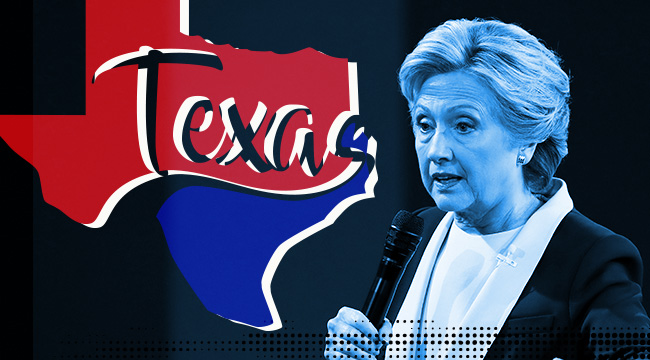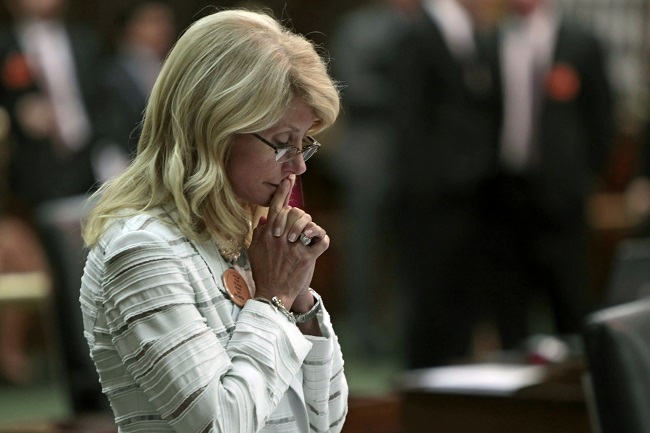
Something very interesting is happening in the Lone Star State. According to recent polls conducted by the University of Houston and the Washington Post/Survey Monkey, Republican nominee Donald Trump still maintains a lead over his Democratic rival among potential and likely Texas voters. However, Hillary Clinton has made considerable gains against her brash opponent, and if nothing disrupts her campaign’s momentum (or Trump’s many garbage fires) during the final weeks before the general election, she just might turn the state blue for the first time since 1976, when Jimmy Carter beat Gerald Ford in the popular vote.
Even with minimal leads of 3 and 2 points respectively, does Trump’s campaign face that much of an uphill battle against Clinton for winning over Texas? Judging by the endless array of sexual assault allegations levied against the New York real estate mogul, perhaps the former secretary of state actually stands a chance. Maybe her ongoing email controversy pales in comparison to Trump’s sins, past and present, in the eyes of Texas’ undecided voters.
That or, more likely, the state’s largely conservative base of voters are so put off by Trumo that they just can’t bring themselves to support the Republican Party’s pick. Remember, Trump was merciless in his primary season attacks on Texas’ own Ted Cruz — who beat Trump during the primary with double the delegates — and, to a lesser degree, former Texas Governor Rick Perry, both of whom are popular in the state. If that were’t enough, Trump has not been kind to the Bush family, arguably the Royal Family of Texas. Taken all together, it’s possible that Trump has managed to offend too many Republicans in Texas over the last year or so to win the state, even when matched up against the likes of Hillary Clinton.
To better understand these poll numbers and whether or not they prove Clinton stands a chance against Trump in Texas, consider what’s happened in the state since Carter just barely nudged past Ford 40 years ago.
Deep In The Mostly Conservative Heart Of Texas
Before Carter’s victory, Texas often went blue in state and national elections. Aside from a few hiccups after the American Civil War and during the ’80s, Texas governors were generally members of the Democratic Party until George W. Bush took office in 1995. As for casting popular and electoral votes for presidents, the state picked Franklin Delano Roosevelt for all four terms, Harry Truman immediately after, and John F. Kennedy and Texas native Lyndon B. Johnson in the ’60s. Not that any of this means anything, as the state’s blueness didn’t translate into liberal voting records. These politicians were popularly known as “Blue Dog Democrats,” and while their party affiliation remained intact, so too did their southern conservative notions.
Following Ronald Reagan and George H.W. Bush‘s decisive victories in the 1980, 1984 and 1988 presidential elections, however, Texas’ voting tendencies began to change slightly. Whereas Reagan won Texas by over 600,000 and 1.5 million votes in ’80 and ’88, Bush’s 600,000-vote lead over Michael Dukakis in ’88 decreased dramatically when Democratic challenger Bill Clinton clinched the presidency in 1992. Clinton didn’t win Texas that year, but he only lost to Bush by less than 200,000 votes. And when Bob Dole challenged the incumbent four years later, Texas only increased the Republican nominee’s lead by a little over 50,000.
Unfortunately for Texas Democrats and progressives who found hope in Bush and Dole’s short leads over Clinton, George W. Bush knocked it out of the park with his monstrous 2000 and 2004 successes over Al Gore and John Kerry. With almost 1.5 and nearly 2 million votes over Gore and Kerry respectively, Bush had no trouble carrying the state. And despite Barack Obama‘s national victories in 2008 and 2012, Republican challengers John McCain and Mitt Romney managed to maintain Bush’s previous leads with a little over 1 million votes in their respective races.
The Rise And Fall Of Wendy Davis

After Obama’s national win (but Texas loss) in 2012, two significant political events occurred that paved the way for Donald Trump and Hillary Clinton’s current standings in the state. The first was the formation of Battleground Texas, a political action committee founded by Jeremy Bird, the former national field director for the Obama reelection campaign. “This program will make Texas a battleground state by treating it as one,” he told reporters in 2013, adding: “Grassroots voices are already changing this country on a scale that was unheard of in this country a few years ago.”
Bird promised his organization would “[expand] the electorate by registering more voters” and “[mobilize] Texans who are already registered voters but who have not been engaged in the democratic process.” And while critics saw Battleground Texas’ efforts as futile in light of McCain and Romney’s margins, many changed their tune when a bit of fluke political theater — State Senator Wendy Davis’ filibuster against an anti-abortion bill — captured the nation’s attention in the summer of 2013. This, along with the senator’s subsequent gubernatorial campaign, garnered Battleground Texas’ support and became the second pivotal moment to pave the way for Clinton’s closing in on Trump’s lead.
Yet things didn’t go so well for Davis. Despite massive statewide and national pushes for her campaign, the Texas Democratic nominee for governor lost in a landslide election to Republican Lt. Governor Greg Abbott. This led to a greater fallout than the state’s borders, as politicos and comedians alike vilified those whose efforts to turn Texas blue had so publicly backfired in their faces.
Trumped At The Polls
Yet here we are, two years after the disastrous state elections and wondering whether or not Trump’s projected 3- and 2-point leads over Clinton mean Democrats may finally have their day in the Lone Star State. Despite a Real Clear Politics polling average of 5.7 points for the Republican nominee, the Washington Post, Austin-American Statesman, FiveThirtyEight and countless others are all asking the same question. Is this actually going to happen this time?
Writing for the Post, Philip Bump recalls an equally large series of polls (released by the paper in September) that claimed Clinton led Trump by one point in Texas. “If Clinton beats Trump by a wide enough margin overall, that means she’s pulled a number of states to the left. And it means that, yes, she could win Texas,” he explains, while adding that the more recent polls are “not super insightful.” As for FiveThirtyEight’s Nate Silver, Clinton’s potential gain in Texas and other red states “could yield an inefficient distribution of the popular vote for her, in terms of its impact on the Electoral College.” In other words, her gains with the popular vote in Texas and other conservative-leaning states may not translate into electoral votes.
Besides, many of the political gains imagined by Battleground Texas and state progressives have less to do with the current election and more to do with the region’s changing demographics. While the state’s traditionally white majority is declining in numbers, its Hispanic minority will outnumber them by 2020. So too are Texas’ Asian-American and African-American populations, and considering these groups’ penchant for voting blue, there’s a good chance the state will opt for the Democratic presidential nominee in future elections. Just not this one.

